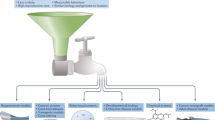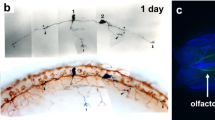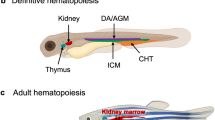Abstract
Fish have a long history of use in cancer toxicology studies, because they develop neoplasms that are histologically similar to human cancers. Because of considerable progress in zebrafish genetics and genomics over the past few years, the zebrafish system has provided many useful tools for studying basic biological processes. These tools include forward genetic screens, transgenic models, specific gene disruptions and small-molecule screens. By combining carcinogenesis assays, genetic analyses and small-molecule screening techniques, the zebrafish is emerging as a powerful system for identifying novel cancer genes and for cancer drug discovery.
This is a preview of subscription content, access via your institution
Access options
Subscribe to this journal
Receive 12 print issues and online access
$209.00 per year
only $17.42 per issue
Buy this article
- Purchase on Springer Link
- Instant access to full article PDF
Prices may be subject to local taxes which are calculated during checkout




Similar content being viewed by others
References
Detrich, H. W., Westerfield, M. & Zon, L. I. Overview of the Zebrafish system. Methods Cell Biol. 59, 3–10 (1999).
Streisinger, G., Walker, C., Dower, N., Knauber, D. & Singer, F. Production of clones of homozygous diploid zebrafish (Brachydanio rerio). Nature 291, 293–296 (1981).
Grunwald, D. J. & Streisinger, G. Induction of recessive lethal and specific locus mutations in the zebrafish with ethyl nitrosourea. Genet. Res. 59, 103–116 (1992).
Driever, W. & Fishman, M. C. The zebrafish: heritable disorders in transparent embryos. J. Clin. Invest. 97, 1788–1794 (1996).
Eisen, J. S. Zebrafish make a big splash. Cell 87, 969–977 (1996).
Dooley, K. & Zon, L. I. Zebrafish: a model system for the study of human disease. Curr. Opin. Genet. Dev. 10, 252–256 (2000).
Penberthy, W. T., Shafizadeh, E. & Lin, S. The zebrafish as a model for human disease. Front. Biosci. 7, d1439–d1453 (2002).
Taft, W. H. Cancer in Fishes House document no. 848, 61st Congress, 2nd session, 1–3 (US House of Representatives, Washington DC, 1910).
Rettig, R. A. in Cancer Crusade: The Story of the National Cancer Act of 1971 42–76 (Joseph Henry Press, Washington DC, 2000).
Gordon, M. Hereditary basis of melanosis in hybrid fishes. Am. J. Cancer 15, 1495–1523 (1931).
Walter, R. B. & Kazianis, S. Xiphophorus interspecies hybrids as genetic models of induced neoplasia. Ilar J. 42, 299–321 (2001).
Law, J. M. Mechanistic considerations in small fish carcinogenicity testing. Ilar J. 42, 274–284 (2001).
Stanton, M. Diethylnitrosamine-induced hepatic degeneration and neoplasia in the aquarium fish, Brachydanio rerio. J. Natl Cancer Inst. 34, 117–130 (1965).
Bunton, T. E. Experimental chemical carcinogenesis in fish. Toxicol. Pathol. 24, 603–618 (1996).
Bunton, T. E. Hepatopathology of diethylnitrosamine in the medaka (Oryzias latipes) following short-term exposure. Toxicol. Pathol. 18, 313–323 (1990).
Hendricks, J. D. Development of the Zebra Danio model: Carcinogenesis and Gene Transfer Studies (US Army, National Information Technology Service, Springfield, Virginia, 1996).
Tsai, H. W. Evolution of Zebrafish (Danio rerio) as a Model for Carcinogenesis. Ph.D. Thesis, Oregon State Univ., 1996.
Spitsbergen, J. M. & Kent, M. L. The state of the art of the zebrafish model for toxicology and toxicologic pathology research — advantages and current limitations. Toxicol. Pathol. 31 (Suppl), 62–87 (2003).
Streisinger, G. Attainment of minimal biological variability and measurements of genotoxicity: production of homozygous diploid zebra fish. Natl Cancer Inst. Monogr. 65, 53–58 (1984).
Spitsbergen, J. M. et al. Neoplasia in zebrafish (Danio rerio) treated with N-methyl-N′-nitro-N-nitrosoguanidine by three exposure routes at different developmental stages. Toxicol. Pathol. 28, 716–725 (2000).
Spitsbergen, J. M. et al. Neoplasia in zebrafish (Danio rerio) treated with 7,12-dimethylbenza[a]anthracene by two exposure routes at different developmental stages. Toxicol. Pathol. 28, 705–715 (2000).
Beckwith, L. G., Moore, J. L., Tsao-Wu, G. S., Harshbarger, J. C. & Cheng, K. C. Ethylnitrosourea induces neoplasia in zebrafish (Danio rerio). Lab. Invest. 80, 379–385 (2000).
Tsao-Wu, G. S., Weber, C. H., Budgeon, L. R. & Cheng, K. C. Agarose-embedded tissue arrays for histologic and genetic analysis. Biotechniques 25, 614–618 (1998).
Moore, J. L., Aros, M., Steudel, K. G. & Cheng, K. C. Fixation and decalcification of adult zebrafish for histological, immunocytochemical, and genotypic analysis. Biotechniques 32, 296–298 (2002).
Spitsbergen, J. M. & Wolfe, M. J. The riddle of hepatic neoplasia in brown bullheads from relatively unpolluted waters in New York State. Toxicol. Pathol. 23, 716–725 (1995).
Okihiro, M. S. & Hinton, D. E. Progression of hepatic neoplasia in medaka (Oryzias latipes) exposed to diethylnitrosamine. Carcinogenesis 20, 933–940 (1999).
Langheinrich, U., Hennen, E., Stott, G. & Vacun, G. Zebrafish as a model organism for the identification and characterization of drugs and genes affecting p53 signaling. Curr. Biol. 12, 2023–2028 (2002).
Nasevicius, A. & Ekker, S. C. Effective targeted gene 'knockdown' in zebrafish. Nature Genet. 26, 216–220 (2000).
Bailey, G. S., Williams, D. E. & Hendricks, J. D. Fish models for environmental carcinogenesis: the rainbow trout. Environ. Health Perspect. 104 (Suppl. 1), 5–21 (1996).
Chang, Y. J. et al. Analysis of ras gene mutations in rainbow trout liver tumors initiated by aflatoxin B1. Mol. Carcinog. 4, 112–119 (1991).
Fong, A. T. et al. Carcinogenicity, metabolism and Ki-ras proto-oncogene activation by 7,12-dimethylbenz[a]anthracene in rainbow trout embryos. Carcinogenesis 14, 629–635 (1993).
Hendricks, J. D., Cheng, R., Shelton, D. W., Pereira, C. B. & Bailey, G. S. Dose-dependent carcinogenicity and frequent Ki-ras proto-oncogene activation by dietary N-nitrosodiethylamine in rainbow trout. Fundam. Appl. Toxicol. 23, 53–62 (1994).
Downward, J. Targeting RAS signalling pathways in cancer therapy. Nature Rev. Cancer 3, 11–22 (2003).
Chin, L., Pomerantz, J. & DePinho, R. A. The INK4a/ARF tumor suppressor: one gene, two products, two pathways. Trends Biochem. Sci. 23, 291–296 (1998).
Folkman, J. Role of angiogenesis in tumor growth and metastasis. Semin. Oncol. 29, 15–18 (2002).
Nasevicius, A., Larson, J. & Ekker, S. C. Distinct requirements for zebrafish angiogenesis revealed by a VEGF-A morphant. Yeast 17, 294–301 (2000).
Habeck, H., Odenthal, J., Walderich, B., Maischein, H. & Schulte-Merker, S. Analysis of a zebrafish VEGF receptor mutant reveals specific disruption of angiogenesis. Curr. Biol. 12, 1405–1412 (2002).
Brown, L. A. et al. Insights into early vasculogenesis revealed by expression of the ETS-domain transcription factor Fli-1 in wild-type and mutant zebrafish embryos. Mech. Dev. 90, 237–252 (2000).
Liao, W., Ho, C. Y., Yan, Y. L., Postlethwait, J. & Stainier, D. Y. Hhex and scl function in parallel to regulate early endothelial and blood differentiation in zebrafish. Development 127, 4303–4313 (2000).
Gering, M., Rodaway, A. R., Gottgens, B., Patient, R. K. & Green, A. R. The SCL gene specifies haemangioblast development from early mesoderm. EMBO J. 17, 4029–4045 (1998).
Weinstein, B. M. Plumbing the mysteries of vascular development using the zebrafish. Semin. Cell Dev. Biol. 13, 515–522 (2002).
Long, Q. et al. GATA-1 expression pattern can be recapitulated in living transgenic zebrafish using GFP reporter gene. Development 124, 4105–4111 (1997).
Picker, A., Scholpp, S., Bohli, H., Takeda, H. & Brand, M. A novel positive transcriptional feedback loop in midbrain-hindbrain boundary development is revealed through analysis of the zebrafish pax2.1 promoter in transgenic lines. Development 129, 3227–3239 (2002).
Langenau, D. M. et al. Myc-induced T cell leukemia in transgenic zebrafish. Science 299, 887–890 (2003).
Fan, L., Alestrom, A., Alestrom, P. & Collodi, P. Development of cell cultures with competency for contributing to the zebrafish germ line. Crit. Rev. Eukary. Gene Exp. (in the press).
McCallum, C. M., Comai, L., Greene, E. A. & Henikoff, S. Targeting induced local lesions in genomes (TILLING) for plant functional genomics. Plant Physiol. 123, 439–442 (2000).
Wienholds, E., Schulte-Merker, S., Walderich, B. & Plasterk, R. H. Target-selected inactivation of the zebrafish rag1 gene. Science 297, 99–102 (2002).
Patton, E. E. & Zon, L. I. The art and design of genetic screens: zebrafish. Nature Rev. Genet. 2, 956–966 (2001).
Weinstein, B. M., Stemple, D. L., Driever, W. & Fishman, M. C. Gridlock, a localized heritable vascular patterning defect in the zebrafish. Nature Med. 1, 1143–1147 (1995).
Zhong, T. P., Rosenberg, M., Mohideen, M. A., Weinstein, B. & Fishman, M. C. gridlock, an HLH gene required for assembly of the aorta in zebrafish. Science 287, 1820–1824 (2000).
Stainier, D. Y., Weinstein, B. M., Detrich, H. W., Zon, L. I. & Fishman, M. C. Cloche, an early acting zebrafish gene, is required by both the endothelial and hematopoietic lineages. Development 121, 3141–3150 (1995).
Cheng, K. C. & Moore, J. L. Genetic dissection of vertebrate processes in the zebrafish: a comparison of uniparental and two-generation screens. Biochem. Cell Biol. 75, 525–533 (1997).
Amsterdam, A. & Hopkins, N. Retrovirus-mediated insertional mutagenesis in zebrafish. Methods Cell Biol. 60, 87–98 (1999).
Golling, G. et al. Insertional mutagenesis in zebrafish rapidly identifies genes essential for early vertebrate development. Nature Genet. 31, 135–140 (2002).
Peterson, R. T., Link, B. A., Dowling, J. E. & Schreiber, S. L. Small molecule developmental screens reveal the logic and timing of vertebrate development. Proc. Natl Acad. Sci. USA 97, 12965–12969 (2000).
Peterson, R. T., Mably, J. D., Chen, J. N. & Fishman, M. C. Convergence of distinct pathways to heart patterning revealed by the small molecule concentramide and the mutation heart-and-soul. Curr. Biol. 11, 1481–1491 (2001).
Chan, J., Bayliss, P. E., Wood, J. M. & Roberts, T. M. Dissection of angiogenic signaling in zebrafish using a chemical genetic approach. Cancer Cell 1, 257–267 (2002).
Shimoda, N. et al. Zebrafish genetic map with 2000 microsatellite markers. Genomics 58, 219–232 (1999).
Knapik, E. W. et al. A microsatellite genetic linkage map for zebrafish (Danio rerio). Nature Genet. 18, 338–343 (1998).
Cheng, R. et al. Cloning, sequencing, and embryonic expression of an N-ras proto-oncogene isolated from an enriched zebrafish (Danio rerio) cDNA library. Mol. Mar. Biol. Biotechnol. 6, 40–47 (1997).
Bisgrove, B. W., Raible, D. W., Walter, V., Eisen, J. S. & Grunwald, D. J. Expression of c-ret in the zebrafish embryo: potential roles in motoneuronal development. J. Neurobiol. 33, 749–768 (1997).
Parichy, D. M., Rawls, J. F., Pratt, S. J., Whitfield, T. T. & Johnson, S. L. Zebrafish sparse corresponds to an orthologue of c-kit and is required for the morphogenesis of a subpopulation of melanocytes, but is not essential for hematopoiesis or primordial germ cell development. Development 126, 3425–3436 (1999).
Cheng, R. et al. Zebrafish (Danio rerio) p53 tumor suppressor gene: cDNA sequence and expression during embryogenesis. Mol. Mar. Biol. Biotechnol. 6, 88–97 (1997).
Thisse, C., Neel, H., Thisse, B., Daujat, S. & Piette, J. The Mdm2 gene of zebrafish (Danio rerio): preferential expression during development of neural and muscular tissues, and absence of tumor formation after overexpression of its cDNA during early embryogenesis. Differentiation 66, 61–70 (2000).
Schreiber-Agus, N., Horner, J., Torres, R., Chiu, F. C. & DePinho, R. A. Zebra fish myc family and max genes: differential expression and oncogenic activity throughout vertebrate evolution. Mol. Cell. Biol. 13, 2765–2775 (1993).
Manickam, P. et al. Isolation, characterization, expression and functional analysis of the zebrafish ortholog of MEN1. Mamm. Genome 11, 448–454 (2000).
Postlethwait, J., Amores, A., Force, A. & Yan, Y. in Methods in Cell Biology. Vol. 60 (eds Detrich, W., Westerfield, M. & Zon, L.) 149–163 (Academic Press, San Diego, 1999).
Yang, B. et al. Purification, cloning, and characterization of the CEL I nuclease. Biochemistry 39, 3533–3541 (2000).
Streisinger, G., Coale, F., Taggart, C., Walker, C. & Grunwald, D. J. Clonal origins of cells in the pigmented retina of the zebrafish eye. Dev. Biol. 131, 60–69 (1989).
Lawson, N. D. & Weinstein, B. M. In vivo imaging of embryonic vascular development using transgenic zebrafish. Dev. Biol. 248, 307–318 (2002).
Acknowledgements
We would like to thank J. Amatruda, C. Belair, C. Erter, K. Lindahl, R. Murphey, E. Patton and J. Shepard for critical reading of the manuscript, and E. Patton for artistic contributions to the figures. K. Cheng, J. Glickman, R. Lamason and J. Moore are thanked for contributing photographs. H.M.S. is supported by a grant from the National Institute of Diabetes and Digestive and Kidney Diseases. L.I.Z. is supported by funds from the National Insitutes of Health and is an Investigator of the Howard Hughes Medical Institute.
Author information
Authors and Affiliations
Related links
Related links
DATABASES
LocusLink
FURTHER INFORMATION
The Children's Hospital Zebrafish Genome Initiative
Stanford Zebrafish Genome Project
Tübingen Map of the Zebrafish Genome
Washington University Zebrafish Genome Resources Project
Web site for Christine Nüsslein-Volard, Max Plank Institute
Website for Brant Weinstein, NICHD
The Zebrafish Information Network (ZFIN)
Zebrafish Webserver at the Cardiovascular Research Center, Massachusetts General Hospital
Glossary
- DESMOPLASTIC STROMAL RESPONSE
-
Also called reactive fibrosis. Collagen deposition and fibroblast proliferation as a stromal response to an invasive cancer.
- NUCLEAR PLEOMORPHISM
-
Variation in nuclear size and shape.
- PROPTOSIS
-
An outward protrusion of the eye.
- SYNTENY
-
The arrangement of mapped genes on a single chromosome. All loci on one chromosome are said to be syntenic (literally, 'on the same ribbon').
Rights and permissions
About this article
Cite this article
Stern, H., Zon, L. Cancer genetics and drug discovery in the zebrafish. Nat Rev Cancer 3, 533–539 (2003). https://doi.org/10.1038/nrc1126
Issue Date:
DOI: https://doi.org/10.1038/nrc1126
This article is cited by
-
Enduring questions in regenerative biology and the search for answers
Communications Biology (2023)
-
Fish genomics and its impact on fundamental and applied research of vertebrate biology
Reviews in Fish Biology and Fisheries (2022)
-
Edelfosine nanoemulsions inhibit tumor growth of triple negative breast cancer in zebrafish xenograft model
Scientific Reports (2021)
-
Induction of mitochondria-mediated apoptosis and suppression of tumor growth in zebrafish xenograft model by cyclic dipeptides identified from Exiguobacterium acetylicum
Scientific Reports (2020)
-
Current basis and future directions of zebrafish nutrigenomics
Genes & Nutrition (2019)



